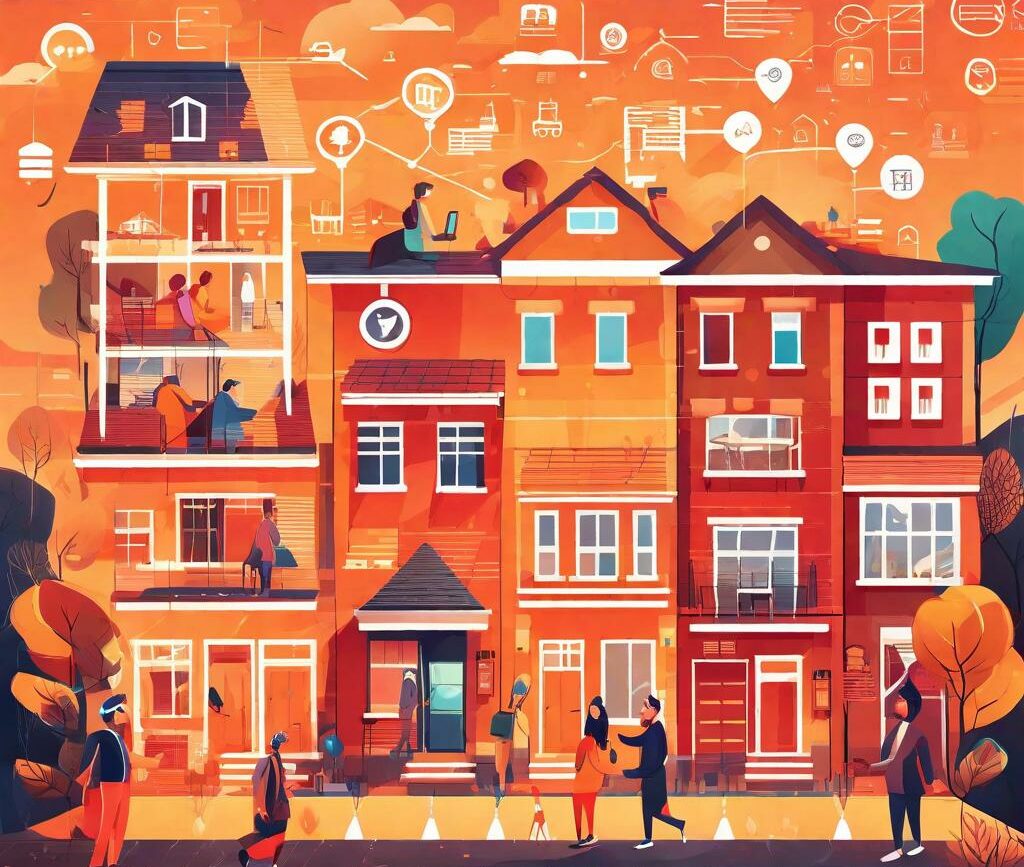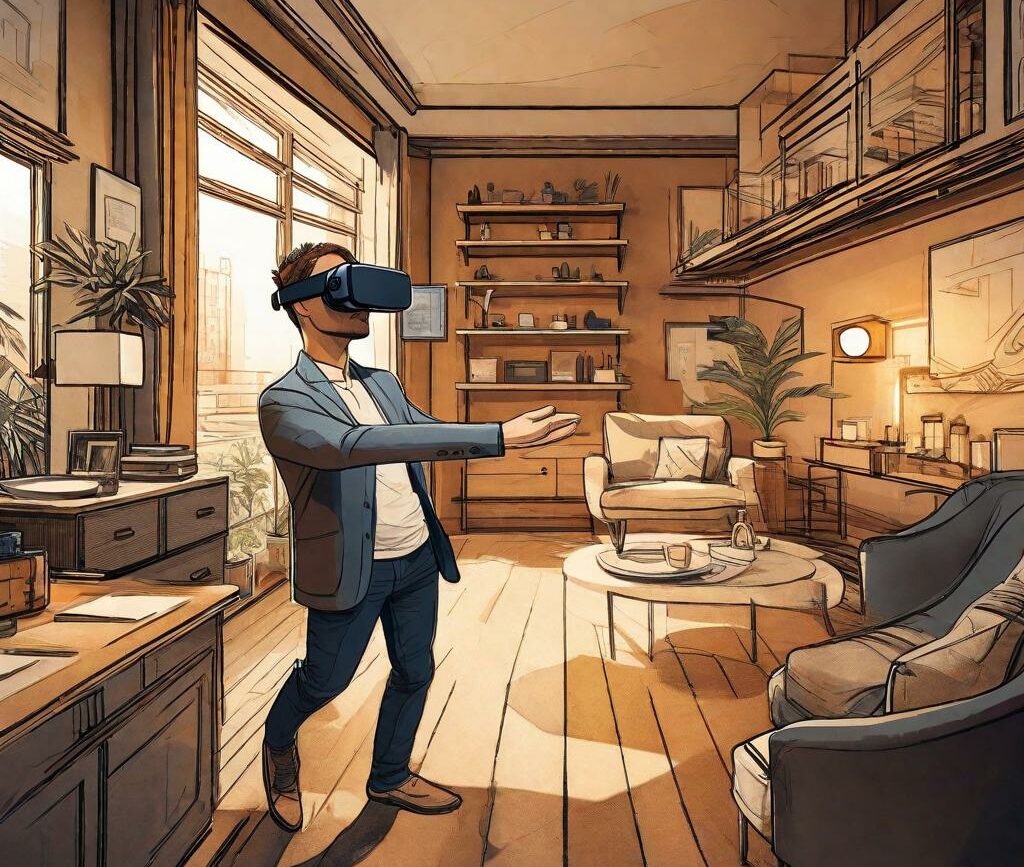
The real estate industry has witnessed a significant transformation in recent years, particularly in the way properties are explored and marketed. Traditional methods of physically visiting properties have been revolutionized by the advent of virtual reality technology and the widespread use of social media platforms. This article delves into the immersive world of virtual property tours and their impact on the real estate industry, from enhancing visualization to expanding reach through social media.
Immersive Experiences: Virtual Property Tours
A. Enhancing Visualization through 360° Virtual Reality Tours
1. The Concept of 360° Virtual Reality Tours
Gone are the days of static property images and floor plans. 360° virtual reality tours provide a dynamic and immersive experience for prospective buyers. Through the use of specialized cameras, these tours capture every angle and corner of a property, allowing viewers to explore it as if they were physically present.
2. How 360° Virtual Reality Tours Facilitate Detailed Property Exploration
With a virtual reality headset or simply through their computers or mobile devices, potential buyers can navigate through a property, examining each room, hallway, and outdoor space. This level of detail enables them to get a thorough understanding of the property’s layout, design elements, and even the flow of natural light.
3. The Impact of 360° Virtual Reality Tours on Buyer Decision-Making
Research has shown that properties with 360° virtual reality tours receive significantly higher levels of buyer engagement compared to those without. By providing a realistic preview of the property, these tours help buyers make more informed decisions, saving them time and effort by narrowing down their choices prior to physical showings.
B. Interactive Floor Plans: A New Dimension to Property Tours
1. Introduction to Interactive Floor Plans
Interactive floor plans go beyond traditional 2D representations by incorporating interactive elements. Users can manipulate the floor plan, zoom in or out, and access additional information such as room dimensions, furniture placement options, and even photos or videos of specific areas.
2. Navigating Property Layouts through Interactive Floor Plans
Prospective buyers can easily visualize how their furniture and belongings would fit within a property through interactive floor plans. By virtually moving around furniture and experimenting with different room layouts, they can gain a better understanding of the property’s potential and envision themselves living in the space.
3. The Benefits of Interactive Floor Plans for Property Buyers and Sellers
Interactive floor plans offer a valuable tool for both buyers and sellers. Buyers can effectively assess a property’s suitability prior to physical visits, while sellers can highlight the unique features of their property and cater to specific buyer preferences. This level of engagement can increase buyer interest and facilitate quicker sales.
C. Real-Time Virtual Showings: Bringing Properties to Life
1. The Advantages of Real-Time Virtual Showings
Real-time virtual showings allow buyers to experience a property in real-time, from the comfort of their own homes. Through platforms like Zoom or FaceTime, real estate agents guide potential buyers through a property, answering questions, and providing detailed information. This interactive approach allows for a personalized and customized experience.
2. How Real-Time Virtual Showings Bridge the Gap of Physical Distance
Buyers who are unable to physically visit a property due to geographical constraints or time limitations can still engage in virtual showings. Real-time virtual showings enable individuals to explore properties located in different cities or countries, opening up a world of possibilities and expanding their options.
3. Establishing Trust and Confidence through Real-Time Virtual Showings
Virtual showings provide transparency and build trust between buyers and sellers. By offering live tours and immediate feedback, real estate agents can address buyer concerns and provide real-time insights. This level of transparency helps buyers feel confident in their decision-making process and establishes a solid foundation for further negotiations.
Social Media Platforms and Virtual Property Tours
A. Leveraging Social Media for Virtual Property Tours
1. Social Media as a Powerful Marketing Tool for Real Estate
Social media platforms, such as Instagram and Facebook, have revolutionized the way real estate is marketed. These platforms offer a global reach and provide opportunities for targeted advertising, making them ideal for showcasing virtual property tours and reaching potential buyers.
2. Expanding Reach and Engagement through Social Media Platforms
Social media platforms allow real estate agents and agencies to reach a vast audience, including those actively searching for properties, as well as those who may not be actively looking but could be enticed by captivating content. By leveraging hashtags, geotagging, and engaging captions, real estate professionals can maximize their property exposure and engagement levels.
3. Tapping into Targeted Audiences through Social Media Advertising
Social media advertising enables real estate professionals to precisely target specific demographics, interests, and locations. By utilizing advanced targeting options, they can ensure that their virtual property tours reach those who are most likely to be interested, increasing the chances of generating leads and ultimately closing sales.
B. Instagram: Showcasing Properties in a Visual Wonderland
1. Instagram Stories and IGTV: Immersive Storytelling for Real Estate
Instagram’s features, such as Stories and IGTV, provide opportunities for real estate professionals to create immersive and engaging content. Through short video clips or longer-form videos, they can take viewers on a virtual journey through a property, showcasing its unique features, design elements, and even the surrounding neighborhood.
2. Hashtags and Geotagging: Maximizing Property Exposure on Instagram
Hashtags and geotagging on Instagram enable real estate professionals to extend the reach of their virtual property tours. By using strategic hashtags related to location, property features, and lifestyle, they can tap into relevant communities and increase the chances of attracting potential buyers who are actively searching for properties.
3. Collaborations with Influencers: Strengthening Real Estate Promotion on Instagram
Partnering with influencers who have a substantial following in the real estate or design niche can significantly amplify the promotion of virtual property tours. These influencers can create captivating content, share their personal experiences, and provide unique perspectives, ultimately influencing their audience’s perception and generating interest in the showcased properties.
C. Facebook: Building Connections and Communities
1. Facebook Live: Interactive Property Tours for Engaging Audiences
Facebook Live offers real estate professionals the opportunity to conduct live property tours, where viewers can ask questions, comment, and engage with the host in real-time. This interactive approach humanizes the virtual experience, making it more personal and allowing for immediate interaction.
2. Facebook Groups: Nurturing Communities and Facilitating Discussion
Facebook groups dedicated to real estate provide spaces for like-minded individuals to discuss properties, seek advice, and share their experiences. Real estate professionals can leverage these groups to initiate conversations, showcase virtual property tours, and establish themselves as trusted experts within the community.
3. Facebook Ads: Optimizing Targeted Advertising for Real Estate
Facebook’s advertising platform offers various targeting options for real estate professionals. By creating highly targeted ads based on demographics, interests, and location, they can ensure that their virtual property tours reach potential buyers who are most likely to be interested, driving traffic to their listings and increasing the chances of conversions.
Challenges and Future Considerations
A. Ethical Concerns Surrounding Virtual Property Tours
1. Ensuring Authenticity and Transparency in Virtual Representations
While virtual property tours offer a dynamic and immersive experience, it is crucial to ensure that the representations are accurate and transparent. Real estate professionals must provide accurate information, disclose any potential issues or limitations, and refrain from using deceptive techniques to make a property appear better than it is.
2. Addressing Privacy and Security Risks in Virtual Property Tours
Virtual property tours involve sharing visual and personal information about a property. Real estate professionals need to prioritize the privacy and security of both buyers and sellers by implementing secure technology platforms, obtaining necessary consents, and educating users about potential risks.
3. Mitigating Disparities in Access to Virtual Property Tours
Not everyone has equal access to the technology needed for virtual property tours. Some individuals may not have adequate internet connectivity, compatible devices, or the necessary knowledge to navigate virtual tours. It is crucial to consider these disparities and find ways to bridge the digital divide to ensure equal opportunities for all.
B. Overcoming Technical Barriers for Wider Adoption
1. Internet Accessibility and Bandwidth Requirements
Virtual property tours rely heavily on stable and high-speed internet connections. However, not all areas have reliable internet infrastructure, which can hinder the adoption of virtual tours in certain regions. It is essential to address these technical limitations and work towards improving internet accessibility to ensure wider adoption of virtual property tours.
2. Compatibility with Different Devices and Operating Systems
Virtual property tours should be accessible across a range of devices and operating systems to reach a broader audience. Ensuring compatibility with smartphones, tablets, computers, and even virtual reality headsets can enhance the user experience and eliminate barriers to entry.
3. Keeping Up with Advancing Virtual Reality Technologies
Virtual reality technologies are evolving rapidly, offering improved graphics, more realistic experiences, and enhanced interactivity. Real estate professionals need to stay informed about these advancements and adapt their virtual property tour strategies accordingly to provide the best possible experiences for potential buyers.
C. Balancing Virtual and Physical Experiences in Property Buying Process
1. The Importance of Physical Showings and In-Person Experiences
While virtual property tours offer convenience and flexibility, the physical aspect of property exploration cannot be completely replaced. Physical showings allow buyers to experience the property’s atmosphere, proximity to amenities, and neighboring environment, factors that may not be adequately captured in virtual tours.
2. Hybrid Approaches: Harmonizing Virtual and Physical Property Tours
A balanced approach that combines virtual and physical property tours can provide the best of both worlds. Real estate professionals can leverage virtual tours to prequalify potential buyers and narrow down options, followed by physical showings for properties that truly capture their interest.
3. Shaping Future Consumer Expectations in the Real Estate Industry
As virtual property tours become more prevalent in the real estate industry, they shape the expectations of future buyers. Real estate professionals need to adapt to these expectations and continually innovate to provide immersive and engaging experiences that meet the evolving needs of buyers.
Summary and FAQs
A. Summary of Immersive Explorations: Virtual Property Tours through Social Media
Virtual property tours have revolutionized the real estate industry, offering immersive experiences that enhance visualization, engagement, and convenience for potential buyers. Through technologies such as 360° virtual reality tours, interactive floor plans, and real-time virtual showings, buyers can explore properties in unprecedented detail.
Social media platforms, such as Instagram and Facebook, provide channels for real estate professionals to showcase virtual property tours, expand their reach, and engage with targeted audiences. Leveraging features like Instagram Stories, IGTV, Facebook Live, and targeted advertising, the marketing potential of virtual property tours is maximized.
However, virtual property tours also present ethical concerns, privacy and security risks, and disparities in access. Real estate professionals must address these challenges and prioritize authenticity, transparency, privacy, and equal access to ensure a seamless and inclusive virtual property tour experience for all.
Frequently Asked Questions (FAQs)
Are virtual property tours as effective as physical showings?
Virtual property tours offer unique benefits in terms of convenience, prequalification, and extended reach. While they cannot entirely replace physical showings, they have proven to be highly effective in narrowing down options and providing a comprehensive preview of properties, saving time and effort for both buyers and sellers.
How can social media platforms enhance the marketing of real estate properties?
Social media platforms offer a global reach, targeted advertising options, and immersive storytelling capabilities, making them powerful tools for real estate marketing. Through strategic content creation, engagement with online communities, and collaborations with influencers, real estate professionals can showcase virtual property tours and attract potential buyers.
What are the potential risks associated with virtual property tours?
Virtual property tours introduce ethical concerns, such as authenticity and transparency, as well as privacy and security risks. Ensuring accurate representations, safeguarding personal information, and addressing disparities in access are essential to mitigate these risks and provide a trustworthy virtual property tour experience.
Are virtual property tours accessible to everyone?
While virtual property tours offer convenience and accessibility to a wider audience, disparities in internet connectivity, device compatibility, and digital literacy can limit access for some individuals. Addressing these disparities and working towards bridging the digital divide is crucial to ensure equal opportunities for all.
Will virtual property tours replace the need for physical showings?
Virtual property tours cannot entirely replace physical showings, as they cannot replicate the sensory experience of being physically present in a property. However, they play a valuable role in prequalification, narrowing down options, and providing detailed property previews, making physical showings more efficient and effective.
In conclusion, virtual property tours through social media platforms have transformed the real estate industry, offering immersive experiences and expanding marketing opportunities. By embracing technological advancements, addressing challenges, and balancing virtual and physical experiences, real estate professionals can stay ahead of the curve and meet the evolving expectations of buyers in the digital age.





